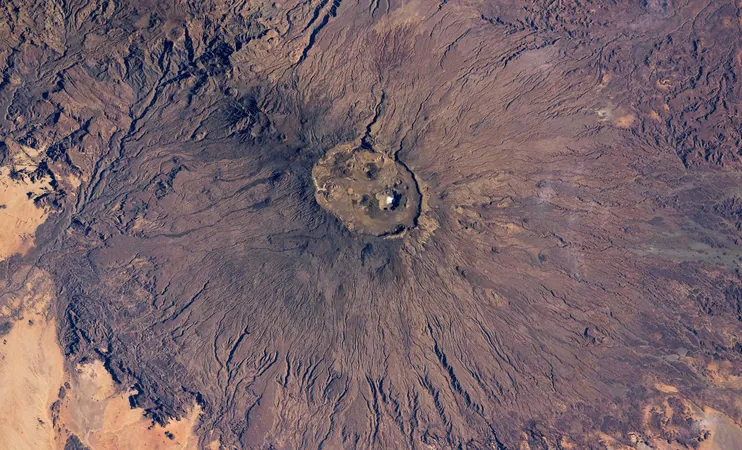
Unveiling a White Wonder: The Secrets of a Mysterious Patch on the Sahara’s Highest Volcano!
2025-05-10
Author: Ming
A Surprising Discovery at Emi Koussi
In a jaw-dropping capture from the International Space Station, the Emi Koussi volcano in northern Chad, the tallest peak in the Sahara, reveals a striking white patch at its summit. At first glance, you might think it’s a blanket of fresh snow, but that illusion quickly shatters—the patch is actually the dried bed of a small lake, now encrusted with salt! Towering at an impressive 3,415 meters (11,204 feet), Emi Koussi dominates the view over the sprawling Sahara.
An Ancient Climate Told by Salt
This remarkable photograph showcases how the once-vibrant lake within the caldera has now succumbed to aridity, leaving behind a striking salt crust. NASA Earth Observatory highlights that this lake's parched remains provide fascinating insights into the Sahara's ancient climate, suggesting that this region wasn’t always the dry expanse we see today. In fact, it bears witness to a time when the Sahara was much wetter, defying our current perceptions.
What Lies Beneath: Evidence of Erosion and Water Flow
The captivating image doesn’t just stop at the salt lake; it unveils several erosion channels winding their way across the volcano’s slopes. Despite the Sahara's notoriously low rainfall, geologists propose that these channels were etched over thousands of years by occasional water flow, showcasing the area's historical connection to water. The vestiges of these riverbeds serve as potent reminders of an era when life was more abundant in this unforgiving desert.
The Sahara: A Landscape of Hidden Histories
This stunning depiction of Emi Koussi shatters the simplistic notion of the Sahara as merely vast sand dunes. It reveals a richly complex geological history characterized by volcanic activity and remnants of ancient water systems. The intriguing interplay of the salt-covered lake and the erosion channels tells a captivating tale of a landscape molded by both fiery forces and the gentle caress of water.
The Future Awaits: What These Findings Mean
As scientists unravel these fascinating features, the implications could change our understanding of not only the Sahara but also other arid regions across the globe. The evidence points to a dynamically shifting climate that can transition from arid to wet. Our perception of deserts, traditionally seen as lifeless expanses, may need a dramatic overhaul. What more secrets lie beneath the sands and salt of the Sahara?




 Brasil (PT)
Brasil (PT)
 Canada (EN)
Canada (EN)
 Chile (ES)
Chile (ES)
 Česko (CS)
Česko (CS)
 대한민국 (KO)
대한민국 (KO)
 España (ES)
España (ES)
 France (FR)
France (FR)
 Hong Kong (EN)
Hong Kong (EN)
 Italia (IT)
Italia (IT)
 日本 (JA)
日本 (JA)
 Magyarország (HU)
Magyarország (HU)
 Norge (NO)
Norge (NO)
 Polska (PL)
Polska (PL)
 Schweiz (DE)
Schweiz (DE)
 Singapore (EN)
Singapore (EN)
 Sverige (SV)
Sverige (SV)
 Suomi (FI)
Suomi (FI)
 Türkiye (TR)
Türkiye (TR)
 الإمارات العربية المتحدة (AR)
الإمارات العربية المتحدة (AR)